

|
Back to |
| The Front Page |
| News & Features |

|
New management signals significant changes at National Croquet Center |
||||||||
|
by Bob Alman photos by Bob Alman and the NCC photo archive Posted June 15, 2009
|
||||||||
|
||||||||
Half a decade of ineffective management of the National Croquet Center has not been entirely wasted. In that time, various managers, staff members, and caterers have made incremental improvements in Center operations and cost efficiencies. The staff have learned their jobs. More and more event planners and corporate and government organizations have been exposed to the Center. And all of that has happened - incredibly - without a well articulated development or business plan. The bad news is that the Center is facing its usual annual end-of-season financial shortfall. But there's a lot of good news, too: Donations have already covered the projected shortfall for calendar 2009. And the best news of all is that there is now the core of a coherent business plan to guide the Center's future development and a CFA board that plans to be actually responsible the Center's success, rather than continuing to pass the problem to a succession of managers who say "I can do it" and then fail in the task.
Early in the summer, there are already significant moves forward, including a revitalized Saturday INTRODUCTION TO CROQUET program - the foundation of membership development; and an announcement from the caterer that there would be lunch from Thursday through Saturday.
But the main difference, this summer, is a very big difference, indeed. This time around, the owners are not merely looking for a new savior; they're delving deeply into the perennial problems of the Center, themselves. They're taking a hands-on approach to actually determining, as a responsible board, what is needed, and in the meantime, they're managing, themselves, the onsite staff, and acknowledging direct responsibility for the results. In fact, there are no immediate plans to hire or otherwise engage another general manager in the near future, following the resignation of Stewart Jackson, who served as a volunteer, unpaid general manager for the last two years, on site throughout the season but not in the summer.
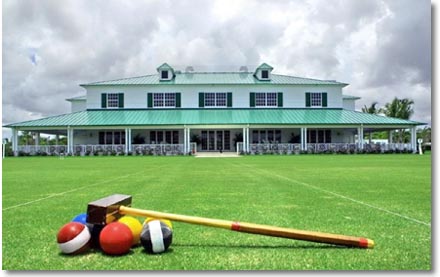
|
| How should the world's finest croquet facility be managed? As a croquet club? An events venue? A social club? A national headquarters? Or all the above? |
In the midst of gloomy times all around, it's reassuring to hear that the owners are taking direct responsibility for the health and survival of the center, rather than passing off the job to the latest in a succession of self-proclaimed "saviors."
In many respects, the National Croquet Center has been managed as a croquet club, instead of the multifunctional business enterprise it actually is, housing a number of separate entities with distinct budgets, goals and operational imperatives. It's not surprising. The expertise of many members of the boards rests largely on managing croquet clubs; and some have never managed any kind of business enterprise of significant complexity.
Putting all these conditions together, persisting over five years, you have a textbook case of long-term organizational dysfunction. Looking at the problem - and the opportunity - from today, this is good news. It means that many of the elements preventing financial viability are visible and easily fixable by any manager with an integrated view of the overall operations, as a function of creating and perfecting a BUSINESS PLAN.
The Center cannot flourish without unitary management
Only a manager can make the National Croquet Center work at an optimal level - or a single, integrated management function as opposed to some kind of "committee management" which - as the past has shown - is virtually no management at all, beyond the level of day-to-day shop-keeping.
With unitary management of the Center - bringing all the functions and operations together in common cause and for mutual benefit - the customer's own unitary experience can be rapidly enhanced. The long-term result of customer satisfaction is a sustaining revenue stream that enables all the entities to provide an even higher level of service, supported by customer traffic that makes it possible.
Membership growth is now the top priority
The consensus is emerging among the operating entities that BUILDING MEMBERSHIP is, at last, the highest priority which, if addressed, is likely to provide the biggest and quickest boost to overall operations, because:
(1) Club membership is the most recession-proof generator of income, year after year.
(2) Members populate the bar and the dining room, and it is members - especially new members, and especially social members - who bring friends as guests to dine with them at the Center - the strangers who contribute to the finances of the Center even if they don't themselves become members.
(3) With lots of activity, the social membership in the club is actually more valuable to all the members who want social contact, including the "serious" players; and especially valuable to the owners and caterer, who need revenue from bar and dining receipts to provide good membership benefits.
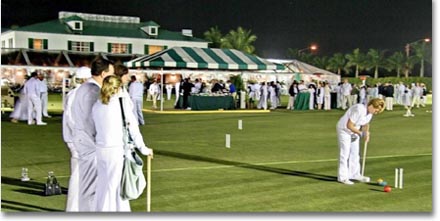
|
| High-rolling financial institutions on elaborate tax-free convention and incentive travel junkets paid a lot of the bills at the Center before the recent fall. This is an elegant CitiGroup evening lawn party, in 2005. |
As the local membership has narrowed down largely to the Palm Beach stalwarts who can afford an annual "Full Membership" fee of $1500, revenue streams have also narrowed, along with the activity necessary to sustain a good social club.
What happened to my friend at the Center
Amazingly, there is currently no such thing as a genuine "social membership" at the National Croquet Center. (The membership labeled "social membership" is actually a "limited membership" that allows full-court play on Thursdays and no other court activity.) The experience of a close friend from Palm Beach whom I introduced to the Center reveals the extent of the problem, through fresh eyes - the viewpoint croquet veterans like me can't easily see for ourselves.
I joined my friend on the lawn a bit after eleven AM on a Saturday morning. She was in the middle of the free public INTRODUCTION TO CROQUET. When I approached, she rolled her eyes and whispered, "I haven't learned a thing! Don't they want members here?"
My friend had been assigned to a four-player pod in the hands of a well-meaning and inept "teacher" who, instead of giving the simple rules of Golf Croquet to the novices, had been telling each player what kind of shot to make in each turn. I politely asked this insructor if I could take over, and proceeded to teach the group Golf Croquet in the remaining 45 minutes. Later this player-pod of four lunched with me at the Croquet Grille, and my friend commented on what a shame it was that the Center was so poorly managed. "It would be so easy to make things work better," she said, "because the problems are so obvious, so easily fixable." This bright and observant woman, experienced in business and a member of nonprofit boards, knows what she's talking about.
A month or so later, I invited this same friend to a Member/Guest Golf Croquet event, with a much better result. In one of our games, she met and played against a "guest" she liked, a woman of similar age, social station, and life experience, and between them, they decided they could join the club, because now they had someone to play with - each other.
Few staff and no managers at the Center in the last five years have appeared to understand what my friend instantly saw for herself in the first visit. To most beginners, croquet is a social enterprise. If a club doesn't sell social opportunities - including putting people together to play games - it isn't going to attract a lot of members. That's exactly what has been happening for the last four years - ever since the genuine "social membership" was abolished, for good reasons that turned out to be bad reasons. That membership featured very limited play on half-courts, which resulted typically in 30 to 50 half-court players gathering at the allowed times to enjoy Golf Croquet, with no worries about having someone to play with. Once novices became hooked on the game, they could promote themselves to a higher (and more expensive) level of membership.
The lesson of this parable is simple: All you have to do to make the Center financial viable through a social club is to look at the operation from the standpoint of the new user. Incredibly, this has not been done in the last five years. The reason? Most people who could have made a difference were wearing their croquet-player blinders, which prevented them even considering what it takes to create and manage a social club - especially a social club with limited, half-court play.
The imminent danger:
Committees and compromises

|
| Who is this man, and why is he laughing? It's David McCoy, the ex-Exxon executive and Croquet Foundation of America board member who is pulling together a business and management plan for the NCC. It's an encouraging "first" for both the CFA board and the Center. |
Local membership was growing steadily beyond the 350 level at the time my membership development plan was fatally compromised in a number of ways not realized by well-meaning people with "good ideas." The goal I and others envisioned was 600. Privately, I thought that 200 might be "serious" croquet players, with Full Membership, and 400 or more would be "social" members, with limited half-court play. That was the scheme established from the beginning of the club, in December 2000, when the lawns opened for play 18 months before the completion of the clubhouse.
Since 2003, largely because of committees and compromises, no development plan has even been articulated, much less implemented. The succession of failed managers, for the most part, have had shopkeeper mentalities, trying to cut costs here and raise prices there to make the finances balance, absent any long-range, integrated development plan. An exception was Terry Colbert, a longtime president of the New York Croquet Club who had sound ideas about croquet's public image and what is needed to build membership, but who was unable to translate those ideas into sufficient results.
The chaos at the Center started the day Chuck Steuber had his debilitating stroke, late in 2001. Many people think the subsequent disasters were because the money stream was cut off, but an equal disaster was losing the active leadership of a man who not only put up the money, but also took responsibility for having the thing work. There were some issues upon which Steuber and I disagreed in the process of organizing and managing the club and the Center, beginning in mid-2000. But they were always ironed out through close examination and discussion of the issues.
That ability to look at the challenges squarely and address them with the correct remedy, instead of a committee's "good idea" has been a huge "what's missing" at the Center.
It was always about membership
A major element in the National Croquet Center's becoming a textbook case of long-term organizational dysfunction has been the persistent failure of the owners to recognize that abundant club membership has always been the proper destiny of this Center, and the explicit purpose for which it was funded and built by Chuck Steuber as "the USCA headquarters facility." To realize this purpose, management needs to create membership categories and benefits that support the rapid development of the club.
Any business professional will walk into the Center, look around, and very quickly spot what needs to be done. The inexpensive SOCIAL memberships that provide limited half-court play automatically build sustaining traffic to the dining room and bar from the group of members most likely to come often and to bring guests - the otherwise clubless middle class.

|
| The Center has changed little since the author snapped this picture in 2003 at a national championship, with wooden ballstops in place. |
Within two or three years, a level of 600 members will be achieved, by which point all the memberships in the "limited" and "social" classes will have become more expensive - not only because they're scarce, but also because they're more valuable for the wealth and variety of stimulating membership events that support the social club and the delightful social ambiance of the bar and the dining room, with daily lunch and weekend dinner hours peopled sufficiently to allow excellent menus with modest prices for members and their guests.
At the point where membership is providing the bulk of the revenue - along with court rentals and USCA-related income - outside events can be chosen very carefully for their profitability and their prestige.
Thus, five years out, the National Croquet Center will have become not just a good events venue and a well-regarded social club, but a PRIME activity center for outside clients and "the best social club membership bargain in South Florida."
Near-term financial prospects
Although the prescription for a healthy future is fairly obvious, whether and how soon and by whom the needed development will be implemented and managed is unclear at this writing. In the near term, the expected shortfall of 2009 calendar year is covered by about $80,000 raised from a recent solicitation campaign. (Putting this together with what paid general managers have received, this would be a "virtual" financial shortfall of more than $160,000 - which is in the high range of the "normal" annual shortfall of the Center, all things considered. But in an economic depression, that's a prudent and reasonable expectation.)
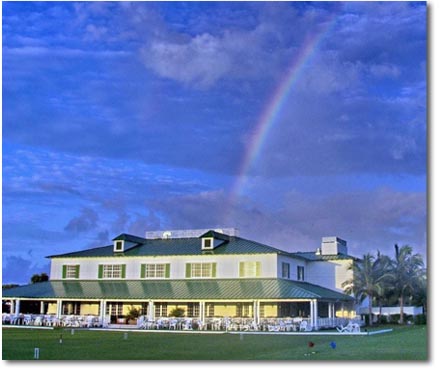
|
| The dark clouds of the gathering economic crisis provide the impetus for the owners of the Center to get serious about developing it as a self-supporting multifunctional business enterprise. After the storm, a rainbow will reappear, prosperity will return, and everyone will live and play happily ever after. |
It is possible that the worldwide economic crisis, with its significant local reverberations, will produce the impetus for finally instituting a workable development plan. If not, the Palm Beach Croquet Establishment has the option of continuing to provide between $100,.000 and $200,000 a year in bailout funding, as long as they wish to keep the Center open as croquet's premier showcase.
In one of his recent letters to members, McCoy contended that is exactly what SHOULD happen, at least until the business plan yields results that preclude the need for outside support. Even then, he comments, doantions should continue but then be committed to broader programs in support of croquet generally, in line with the Croquet Foundation of America's charter.
McCoy likens this to the kind of continuing support people give to their favorite charities. Annual gifts from the many members for whom this wouldn't be a burden would preclude raising dues on everyone to cover the shortfall and losing members as a result. Just as subscriptions and ticket sales cover only about a third of the cost for many theatre and arts organizations, club membership fees currently support only about a third of the National Croquet Center's operating costs. McCoy argues that moderate donations from those who can afford it should be considered an annual duty in support of croquet and the National Croquet Center, not a "bailout."
The big question is whether the "committees" contemplated for the near term can possibly do what is necessary for long-term development. My documented estimate of lost revenue due to the failure to institute organized development is $1,400,000 - up from the estimate of one million documented in this magazine several years ago and still online in the "MEGACENTERS DEVELOPMENT" conversation on Croquet World's Bulletin Board. The table on membership development plots established trend lines over the first five years of full Center operation.

|
| The man with the pleased expression wearing the green-and-white ceramic medallion bearing the image of croquet's "bad boy" has been a principal player in the Center's drama since shortly after founder Chuck Steuber suffered his debilitating stroke, leaving the Center leaderless and without development finances in late 2002. Gary Weltner's main contribution has been to calm the political waters by the most expedient means in numerous financial and management crises of the past, and he is now the president of the Croquet Foundation of America, the owners of the facility. |
So far, the overall coordination of the reorganization effort, by David McCoy and others, has been impressive. Will the best minds be sufficiently engaged, long-term, to get the job done, at last, hands-on? Or will they merely make sound recommendations and walk away, leaving implementation into the hands of......whom?
About a year ago, I privately met with five fairly prominent stakeholders - members who had invested in the Lifetime Membership - to ask what they would do to keep the Center open when the money ran out at the end of May 2009. None of them would promise to single-handedly keep the Center open, but several said, "I can't believe we would ever let this Center go." Their emotional as well as financial commitment ought to be a telling factor.
I was willing to accept their assurances. No member could complain if wealthy members are willing to continue to keep the Center afloat with substantial annual donations. But I'd much prefer to see the Center prospering on its own, for a couple of reasons:
(1) As a member, I'd like to belong to a club with lots of dining and bar action and social activities of all kinds, in addition to the finest croquet around. That would be a lot more fun, and for a social sport, the fun factor is not to be ignored.
(2) As the person who organized and managed the club for the first two and a half years of its existence, I'd like to see the development program that yielded outstanding results in membership numbers up until 2004 refined and restored, to bring back the hundred-plus local SOCIAL members that were such a huge part of fueling the Center's early growth, and multiply their numbers.
(3) As a longtime organizer, I want to see USCA croquet succeed, and I persist in viewing the Center as a potential development model for large croquet clubs in many parts of the country organized around a social model, with world-class courts and four-star meeting and dining facilities. How much more cost efficient is a social club built around croquet rather than golf? The current economic crisis points the way to a largely unexploited path of significant development for USCA croquet: croquet at the Golf Club. Some excellent models exist, and two have been recently explored in depth in two Croquet World articles: "Croquet Comes to College" and "Strategic Planning: A Must for Club Development."
The Palm Beach factor
When I was out beating the bushes for members and corporate event sales back in 2001/2/3, I encountered a red-haired croquet-playing dowager at a social event and asked her why I hadn't seen her at the National Croquet Center, and why she wasn't a member. She said, "I don't go there, because they let the public in." I knew this woman's background. As a hoofer on Broadway, she had connected with a wealthy Palm Beacher, married him, moved to Florida, and lived happily on the mid-slope of the social pyramid, if not at its apex.
Her comment was more amusing in a Marx Brotheres kind of way than she intended it to be, and I don't believe that attitude is widely shared by members of today's Palm Beach croquet establishment, who for the most part support the USCA's goal of broadening the outreach of organized croquet. But it's worthwhile to speculate what the logical result of the original membership development plan would be, beginning with low-cost social membership, culminating in the pre-announced ceiling of 600 members, creating a new condition of "scarcity," and allowing management to confidently raise prices to meet the market demand.
At that point, all the signs on the street inviting "the public" to dine will come down, because there will be sufficient traffic from members and guests to support a thriving cafe and bar. It's at that point that the Social Membership fees will have tripled to at least $1,000 annually, providing the bulk of membership revenue - and without overpopulating the lawns, reserved for "serious": croquet players in the "full membership" category.
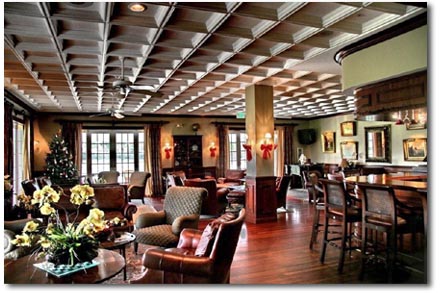
|
| The emptiness of the Members Lounge dramatizes the perennial failure of management to build the social club, with fewer local members today than in 2004, to it's optimum level. This is where the fastest and most spectacular difference can be made, by recreating the membership development program begun in 2000 and later abandoned incrementally and thoughtlessly through five brief generations of management with no well articulated business plan. |
It's at that point that Jack Osborn's dream will have been fully realized - in Palm Beach County, at least. And with that model - whose development has been so long and sadly neglected, the visions of both "founders" will be fully within view, as other "mega-centers" are built around the country on a successful "croquet social club" model that begins to seriously compete with the overbuilt and failing golf club models.
The National Croquet Center:
Designed and managed to succeed
In striking constrast to the Victoria Croquet Centre, the world's other mega-center for croquet, Steuber's South Florida version was elegantly designed and built to succeed not just as a headquarters facility, but also as a large first-rate players club, as a social membership club, and a prime events venue for corporations and private parties. Although major elements of a normal development track at the National Croquet Center have been neglected for five years, almost everything needed for that critical development is now in place, guided by a sound business plan and strong signs of a newly awakened corporate will to implement it.
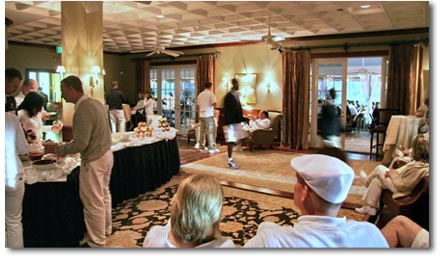
|
| The overall ambiance of the clubhouse is elegant and casual at the same time. The scale of it is closer to a private mansion than a club business, which is why it's so highly favored for private and corporate groups like this one, accommodated both inside and on the wrap-around verandah designed to hold two tiers of tables fronting the croquet lawns. Imagine a resident membership club of 600 members in this environment, and you'll be duplicating the founder's vision for this remarkable national headquarters |
Chuck Steuber might have been smarter than he knew. He might have known that if he built it, ultimately, his croquet players wouldn't let him down. They would finally make it work - and not just work, but succeed brilliantly.
|
HIGHLIGHTS FROM THE "ANALYSIS AND PLAN"
The first encouraging signs of an integrated, long-term development plan appeared in the "Initial Report to the Membership: Analysis and Plan for the National Croquet Center," sent out in May 2009 along with a solicitation for funds which generated more than $80,000 - enough to carry the Center through to the end of calendar 2009 and the beginning of the revenue-rich 2010 "high season." The analysis, authored principally by former Exxon exec David McCoy, outlined all the causes"of the long-term deficits and then proposed these "ACTION STEPS," among others:
|
|
POTENTIAL QUICK FIXES AT THE CENTER
* Corporate communcications have often been unfocused, unclear or ambiguous - leading to confusion and uncertainty about such club essentials as open hours for food and drink. This applies to everything from coordinating messages from the caterer and the members club, to putting prominent signage in the lobby or on the street about dining and bar hours. This is an "obvious" measure to most people, but not obvious to the staff of the various entities of the Center. Which brings up the next point: * Somebody has to connect the dots. An essential function of management is to have all the staff (and in this case, all the corporate entities) work together to create the best result for them all, and for the customer, who ought to have a satisfying UNITARY experience - with no visible distinction between the functions of the different corporate entities operating on site. * The Saturday INTRODUCTION TO CROQUET has not been managed to produce the optimum results. In mid 2003, there were 12 to 15 new members a month; in 2009, it's a small fraction of that, and the retention rate for second-year sign-ups is not impressive. The failure of the Saturday Introductions is not the fault of any one person, but a result of virtual non-management of this essential function of the club, and the result of NOT creating a menu of membership categories and prices that generates significant numbers of new members quickly. * With reduced numbers of local members, membership benefits have been lacking, at a lower level than in the early years of the Center. After years of guaranteed evening dining on Thursday year-round, there has been no regular summer evening dining at all, and insufficient opportunities for new members to get together as a group for fun, for socializing, for play, for learning. Improvements have been made in the "free instruction" arena, but they are insufficient. They don't adequately address the social factor. All these conditions can be quickly and easily addressed, and all the fixes, together, will constitute a quick turnaround in the finances of the Center. How quick is "quick"? In the hospitality industry three years is a norm for initial development. On the foundation already established, if serious development is undertaken in the service of the right business plan, the Center can achieve financial self-sustainability within two years. |